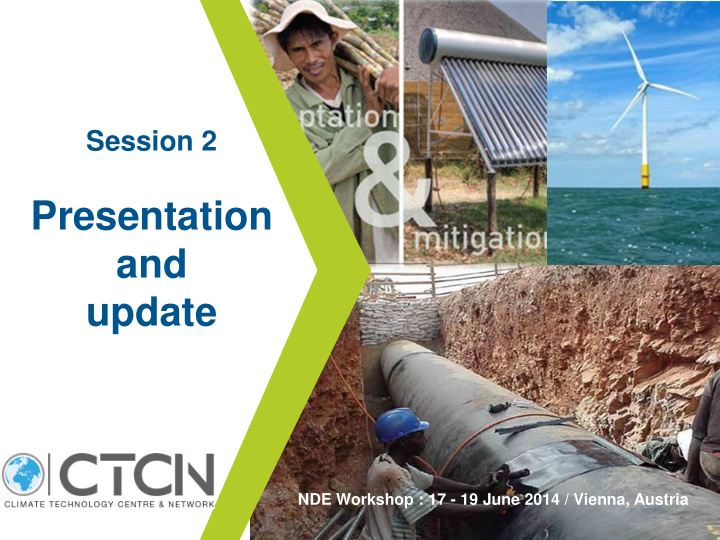



Session 2 Presentation and update NDE Workshop : 17 - 19 June 2014 / Vienna, Austria
OBJECTIVES OF THIS SESSION Introduce the CTCN Origins and mission Functions and structure The crucial role of NDEs The Climate Technology Network CTCN services
BUT FIRST A SHORT EXERCISE… 3
Exercise Guidelines Duration: 15 minutes Material: Sticky notes Each participant writes on sticky notes what their current understanding and expectations of CTCN services are. Participants should use concrete examples of the kind of support they would like to receive, and what they expect from the CTCN. Please write one item per sticky note.
CTCN ORIGINS AND MISSION 5
ORIGINS OF THE CTCN Decisions: UN Framework Convention on Climate Change COP 15 (Copenhagen) 2009: agreement to establish a “Technology Mechanism” COP 16 (Cancun) 2010: Technology Mechanism further elaborated (TEC and CTCN) and Technology Executive Committee created COP 17 (Durban) 2011: establishment of the Climate Technology Centre and Network; selection procedure for host agreed COP 18 (Doha): formal selection of UNEP-led consortium as host of the Centre 6
CTCN MISSION “ TO STIMULATE TECHNOLOGY COOPERATION AND ENHANCE THE DEVELOPMENT AND TRANSFER OF TECHNOLOGIES TO DEVELOPING COUNTRY PARTIES AT THEIR REQUEST.” Parties to the UNFCCC 7
CTCN FUNCTIONS AND STRUCTURE 8
CTCN FUNCTIONS Main functions: Manage requests from developing country National Designated Entities (NDEs) and deliver responses Foster collaboration and access to information and knowledge to accelerate climate technology transfer Strengthen networks, partnerships and capacity building for climate technology transfer Supported by outreach and awareness activities and a robust knowledge management system 9
CTCN STRUCTURE Core Centre co-managed by UNEP and UNIDO, backed by our partner institutions Main support provided through the Network 10
CTCN CONSORTIUM 11
CONSORTIUM EXPERTISE Breadth and depth of expertise and experience in: Adaptation and mitigation, along all steps of the technology cycle Specific technology subject areas Geographic understanding and language capabilities Expertise in knowledge management Network development and management 12
STRATEGIC GUIDANCE AND LIASON WITH CONFERENCE OF THE PARTIES 13
CTCN STRUCTURE – THE NDEs Advisory Board 14
Advisory Board Members selected by COP Provide overall guidance Determine the operational modalities and rules of procedure (eligibility and prioritization criteria for requests; criteria and structure of Network) Provide managerial guidance (approve reports and work programmes, endorse the appointment of the Director, oversee key financial matters) Monitor and evaluate the responses 15
CTCN STRUCTURE – THE CTC The Climate Technology Centre 16
CTCN STRUCTURE – THE CTC Regional Teams • Asia Pacific • Africa • LAC • West Asia 17
THE CLIMATE TECHNOLOGY NETWORK 18
CTCN STRUCTURE – THE CLIMATE TECHNOLOGY NETWORK 19
CONSTRUCTION OF THE NETWORK All NDEs are Network members Exact role will depend on the local context: Coordinate other Network members of the country Disseminate information / help in capacity building Be actively involved in providing technical assistance Qualified institutions encouraged to apply: – Applications assessed against criteria – Merit-base, time bound membership
NETWORK ACTIVITIES Start up phase: knowledge transfer Actively exchange information, experiences, best practices via KMS Provide expertise in training/ capacity building activities Participate in workshops, trainings Future: technical assistance Responding to requests Competitive bidding via UN procurement procedure Highly dependent on the types of requests
THE CRUCIAL ROLE OF NATIONAL DESIGNATED ENTITIES 22
CTCN STRUCTURE – THE NDEs National Designated Entities 23
NATIONAL DESIGNATED ENTITIES Acting as the national CTCN focal point Coordinating activities and services of the CTCN in the country Acting as an active member of the Climate Technology Network (CTN) The success of the CTCN greatly depends on NDEs It is hoped that NDEs will mainstream climate technology issues in all national climate change-related strategies, policies, and plans and become “CLIMATE TECHNOLOGY CHAMPIONS!” 24
NATIONAL DESIGNATED ENTITIES Nomination requested by UNFCCC 82 NDE nominated to date 25
CTCN SERVICES 26
CTCN SERVICES Three core services: 1. Provide technical assistance to developing countries to enhance transfer of climate technologies 2. Provide and share information and knowledge on climate technologies 3. Foster collaboration and networking of stakeholders on climate technologies 27
FOCUS OF CTCN SERVICES Different forms of technical assistance to developing countries All along the technology innovation cycle Value in range $50,000 - $250,000 Funds not provided directly to countries Fast and flexible delivery of support that initiates or triggers larger scale actions 28
Pyramid of CTCN Services
REQUESTS FOR TECHNICAL ASSISTANCE 8 official requests received (Afghanistan, Chile, Columbia, Honduras, Iran and Pakistan) More in the pipeline Adaptation AND mitigation System for monitoring adaptation efforts Design of biodiversity monitoring network Capacities of communities to monitor mangrove forests Support for climate smart agricultural practices M&E of national energy policies Development pilot project of the municipal waste Photovoltaic solar cell design and manufacturing Support and advise for the identification of technology needs 30
Thank you for your attention!
Recommend
More recommend